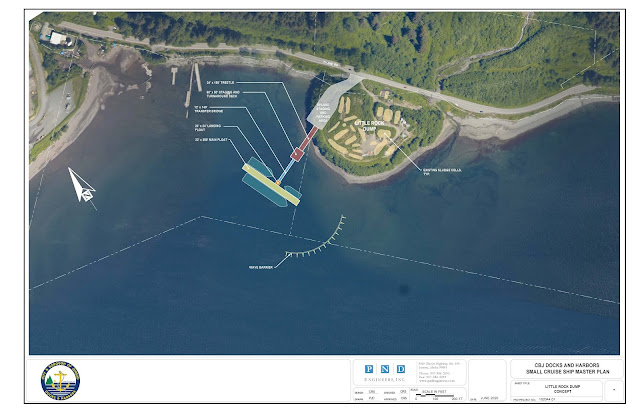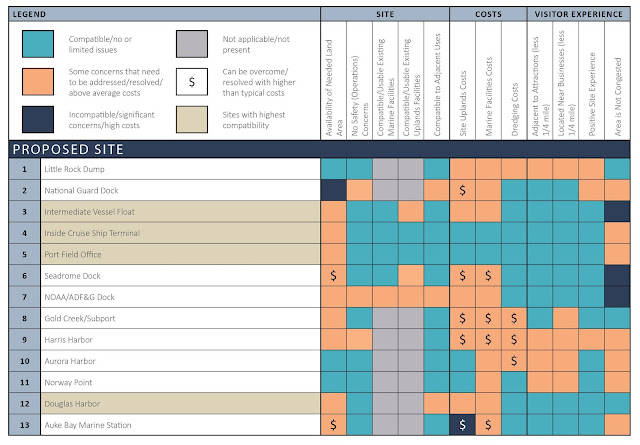Study Sites
The following six sites were chosen for further study as potential development sites for a small cruise ship harbor. These sites include:
- Auke Bay
- Little Rock Dump
- Douglas Harbor
- Harris Harbor
- NCLH/USCG
- NOAA/Seadrome
Concept development and preliminary cost estimates are found below.
Auke Bay Concept
CBJ's Auke Bay Marine Station Plan includes several substantial improvements within Auke Bay intended to expand Statter Harbor to better serve many sectors of Southeast Alaska's maritime industry. Improvements include recreational and commercial boaters, pleasure yachts, small cruise vessels, USCG, NOAA, and other support vessels. Port and harbor improvements include:
- Demolition of the existing floating wave attenuator.
- 1500 LF of new floating wave attenuator/moorage float located approximately 600' offshore.
- 925 LF of new transient moorage float connecting the wave attenuator to the Auke Bay Marine Station.
- ADA compliant covered gangway providing pedestrian access to shore facilities from the new transient float.
- Statter Harbor headwalk float extension and 5,000 LF of new public moorage float.
The plan provides nearly 10,000 LF of additional moorage capacity in Auke Bay with a direct connection to upland support services at the former NOAA site, recently transferred to the CBJ. It also envisions a future pedestrian harbor walk along the shoreline between Statter Harbor and Auke Creek.
Small cruise ships would occupy only a portion of the overall improvements and would likely moor along the proposed 925 LF transient float. While a total project cost for the entire Auke Bay Marine Station are in excess of $66 million, those elements directly related to small cruise ship moorage are budgeted at $15.7 million, including contingency and indirect project costs. Local, state, and federal permits will be required for these proposed improvements.
Little Rock Dump
The existing uplands at the Little Rock Dump site is roughly four acres in size and is currently used for storage and staging of surplus construction materials by the CBJ Docks and Harbors Department. The site once operated as a CBJ wastewater sludge landfill and solid waste facility. It was last used for sludge disposal in 1996 and has since been capped and graded to drain in accordance with an ADEC approved Landfill Closure Plan. Bathymetric conditions to the north of the little Rock Dump are favorable for the siting of necessary marine structures to service small cruise ships without dredging. However, while the Little Rock Dump provides some protection from the strong southeast exposure, it appears that wind and wave conditions along Gastineau Channel could impact moorage operations without some degree of added protection.
The site's topographic relief requires a lower staging and parking area to be constructed from rock fill materials along the northern shoreline. Highway access improvements are also anticipated to accommodate bus turning movements on and off Thane Road. Water and sewer utilities would need to be extended from the Rock Dump approximately 1/2 mile into this area. Power and lighting improvements would also be constructed. Onsite runoff will be collected in a storm drain system and treated per ADEC requirements prior to discharge into Gastineau Channel.
The overall project involves filling the site with approximately 20,000 cubic yards of clean rock subbase, base course, and armor stone prior to site paving. The armor stone materials will blanket the fill slopes of the staging area to prevent coastal erosion caused by currents, waves, and boat wakes in Gastineau Channel. A pile-supported trestle will be extended approximately 150 feet offshore to a 3,000 SF vehicle staging and turnaround deck. A light-duty vehicle and pedestrian transfer bridge will provide access from this pile-supported deck to a landing float connected to a 32' x 350' moorage float. 700 LF of total moorage for small cruise ships will be provided on both sides of the float. A pile-supported permeable wave barrier is anticipated for protection from the southeast exposure. All marine piles will be equipped with sacrificial anodes to control marine corrosion.
Total project budget including construction, 15% contingency, and indirect costs for site investigations, permitting, design, contract administration, and construction inspection has been estimated at $21.9 million. Local, state, and federal permits will be required for the proposed improvements.
Douglas Harbor
A portion of the existing uplands north of the boat launch will be improved with pavement and drainage features to stage and park vehicles near the harbor entrance. A small pile-supported approach dock will be extended from shore providing access to a light-duty pedestrian gangway. The gangeway will land on a gangway landing float connected to a new 20 x 250 moorage float. The new moorage float will be attached to the existing USACE floating wave attenuator at the harbor entrance. Moorage for small cruise ships will be provided on both sides of the combined float with approximately 480 LF of outside moorage and 120 LF of inside moorage at the north end. All marine piles will be equipped with sacrificial anodes to control marine corrosion. Water, sewer, power, lighting, and storm drain improvements would also be included with this project.
Total project budget including construction, 15% contingency, and indirect costs for site investigations, permitting, design, contract administration, and construction inspection has been estimated at $7.6 million. Local, state, and federal permits will be required for the proposed improvements with specific authorization from the USACE allowing use of the federal wave attenuator for moorage purposes.
Harris Harbor
A 585' long sheet pile bulkhead will be constructed along the south slope of the harbor basin adjacent to the Juneau Douglas Bridge. The bulkhead will be backfilled with clean shot rock materials then paved to provide additional upland space for vehicle and pedestrian circulation, parking, and other harbor operations. A pile-supported deck will extend seaward from each end of the bulkhead to provide gangway access to a 16' x 485' moorage float located along the face of the bulkhead. The harbor basin will be dredged up to the bulkhead to provide adequate water depths for all vessels using the facility. A seawalk with architectural safety rails will be provided along the top of the bulkhead to ensure a safe and continuous pedestrian route along the water's edge. Utility extensions into this area include water, sewer, storm drains, power, and area lighting. Onsite runoff will be collected and treated per ADEC requirements prior to discharge into Gastineau Channel.
Total project budget including construction, 15% contingency, and indirect costs for site investigations, permitting, design, contract administration, and construction inspection has been estimated at $18.5 million. Local, state, and federal permits will be required for the proposed improvements.
NCLH/USCG
Norwegian Cruise Line Holdings (NCLH) has acquired property at the Juneau Subport adjacent to the USCG base and has announced plans to develop a new cruise ship dock at their site. Preliminary plans for the cruise ship dock included a pier extending perpendicular to shore roughly 1,200' into Gastineau Channel. A 350' long pile-supported trestle extends from the USCG dock, leading to a transfer bridge that lands on a central floating pontoon measuring 70' x 500'. Mooring dolphins extend seaward from the pontoon to make up the entire marine facility. NCLH intends to moor its cruise ships on the west side of the pontoon and allow the USCG and NOAA to moor smaller vessels along the east side of the pontoon.
A separate moorage float for small cruise ships has also been proposed along the east side of the NCLH pile-supported trestle. This 25' x 280' float would be accessed via gangways located at each end of the float. The primary access gangway extends from the pile-supported trestle near shore and a second gangway connects the proposed small cruise ship float to the NCLH pontoon. Water, sewer, power, and lighting improvements will also be included on the float; however, no uplands are currently available for operations at this site.
Total project budget including construction, 15% contingency, and indirect costs for site investigations, permitting, design, contract administration, and construction inspection has been estimated at $7.1 million. Local, state, and federal permits will be required for the proposed improvements.
NOAA/Seadrome
Significant upland and marine improvements are envisioned at this site that will involve public and private cooperation between CBJ, Goldbelt, and NOAA. The existing parking area at the Seadrome building will be reconfigured and extended offshore with retained fill near shore and new pile-supported structural decks offshore to expand the site for necessary pedestrian and vehicle circulation, staging, and parking. Goldbelt's existing Seadrome float and access gangway will be relocated approximately 160 feet offshore to connect into the new deck system. A new small cruise ship moorage float, 32' x 350' in size, will be located 200' west of the Seadrom Float and will be accessed via a pedestrian and vehicle rated transfer bridge also connected into the new pile-supported deck. The structural decks also provide pedestrian space for a future connecting seawalk in both directions along the waterfront with security screening and access gates along adjacent federal properties. A future gangway connection from the deck to moorage floats fronting Merchant's Wharf is also possible under this concept.
New upland features include access improvements onto Egan Drive, bus staging, expanded vehicle parking, wider sidewalks in front of the Seadrome Building, landscaping, and several covered shelters. Utility improvements include water, sewer, storm drains, power, and area lighting. Onsite runoff will be collected and treated per ADEC requirements prior to discharge into Gastineau Channel. Approximately 31,000 SF of new pile-supported decks with architectural guardrails are envisioned for this project. All marine piles will be equipped with sacrificial anodes to control marine corrosion.
The parking area improvements and access to the small cruise ship float will transit through CBJ, Goldbelt, and NOAA property, requiring legal property agreements between the parties. NOAA vessel operations will be improved by allowing scheduled floating moorage along the west side of the proposed small cruise ship float while in port. Equipment and supply loading operations for NOAA ships will remain from a secured work area at NOAA's pile-supported deck.
Total project budget including construction, 15% contingency, and indirect costs for site investigations, permitting, design, contract administration, and construction inspections has been estimated at $25.























